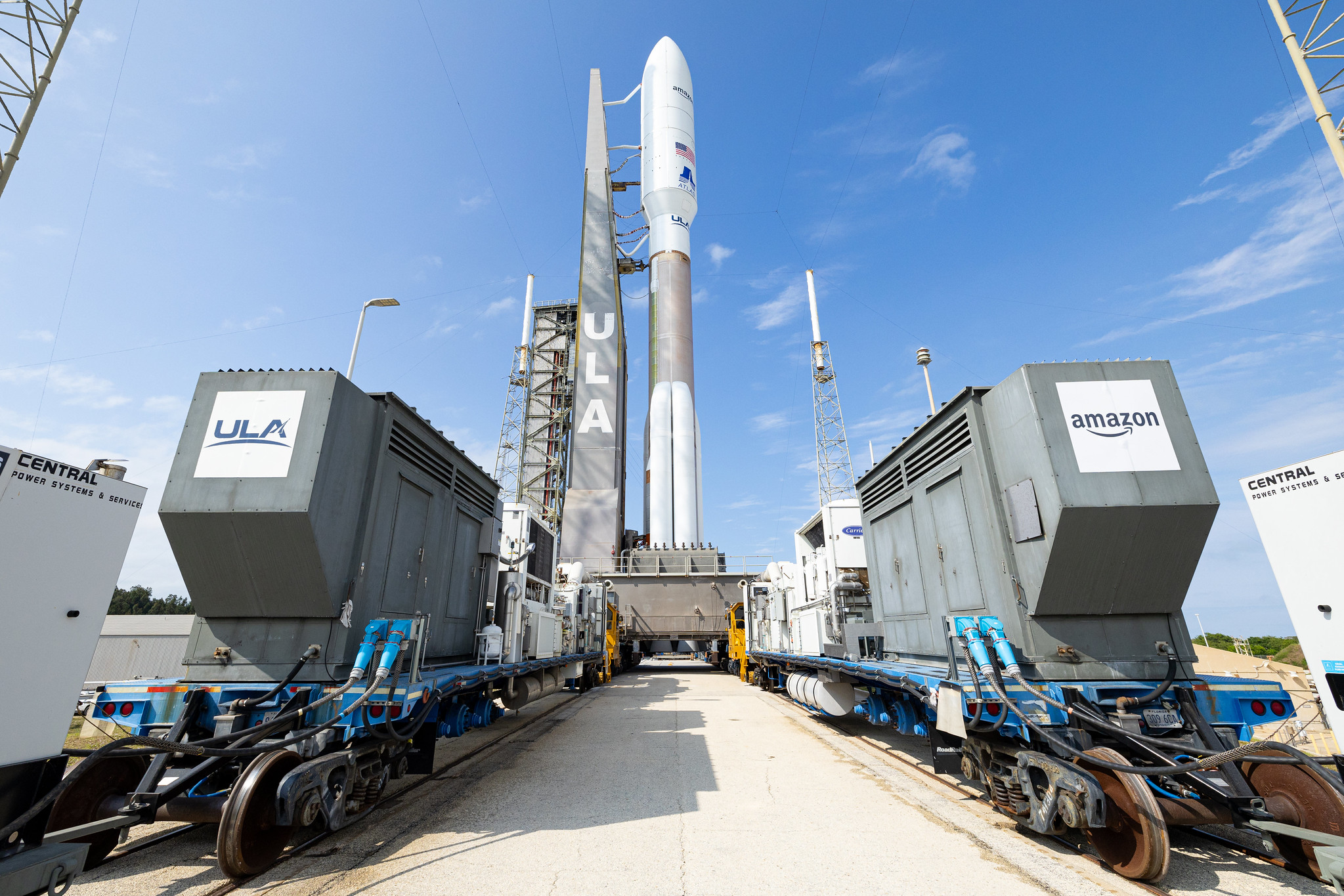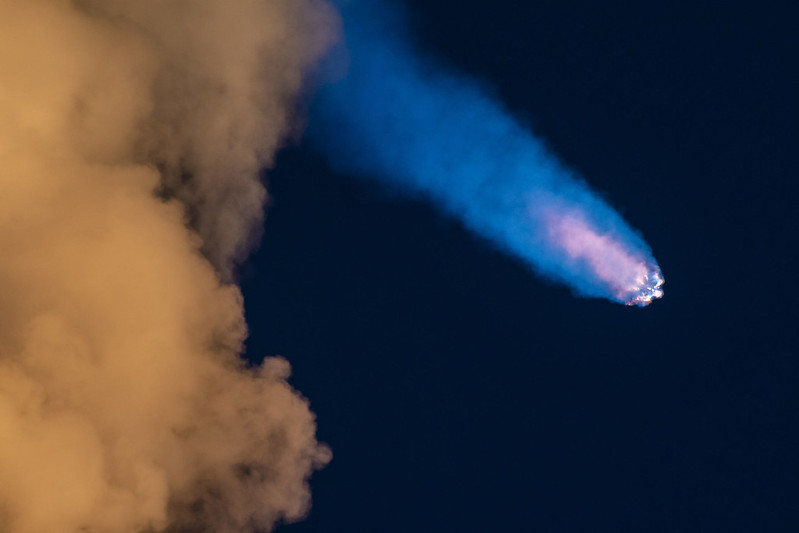The Space Force is looking for responsive launch. This week, they're the unresponsive ones.
File photo of a SpaceX Falcon 9 launch in 2022. Credit: SpaceX

Pushed by trackmobile railcar movers, the Atlas V rocket rolled to the launch pad last week with a full load of 27 satellites for Amazon's Kuiper internet megaconstellation. Credit: United Launch Alliance
Last week, the first operational satellites for Amazon's Project Kuiper broadband network were minutes from launch at Cape Canaveral Space Force Station, Florida.
These spacecraft, buttoned up on top of a United Launch Alliance Atlas V rocket, are the first of more than 3,200 mass-produced satellites Amazon plans to launch over the rest of the decade to deploy the first direct US competitor to SpaceX's Starlink internet network.
However, as is often the case on Florida's Space Coast, bad weather prevented the satellites from launching April 9. No big deal, right? Anyone who pays close attention to the launch industry knows delays are part of the business. A broken component on the rocket, a summertime thunderstorm, or high winds can thwart a launch attempt. Launch companies know this, and the answer is usually to try again the next day.
But something unusual happened when ULA scrubbed the countdown last Wednesday. ULA's launch director, Eric Richards, instructed his team to "proceed with preparations for an extended turnaround." This meant ULA would have to wait more than 24 hours for the next Atlas V launch attempt.
But why?
At first, there seemed to be a good explanation for the extended turnaround. SpaceX was preparing to launch a set of Starlink satellites on a Falcon 9 rocket around the same time as Atlas V's launch window the next day. The Space Force's Eastern Range manages scheduling for all launches at Cape Canaveral and typically operates on a first-come, first-served basis.
The Space Force accommodated 93 launches on the Eastern Range last year—sometimes on the same day—an annual record that military officials are quite proud of achieving. This is nearly six times the number of launches from Cape Canaveral in 2014, a growth rate primarily driven by SpaceX. In previous interviews, Space Force officials have emphasized their eagerness to support more commercial launches. "How do we get to yes?" is often what range officials ask themselves when a launch provider submits a scheduling request.
It wouldn't have been surprising for SpaceX to get priority on the range schedule since it had already reserved the launch window with the Space Force for April 10. SpaceX subsequently delayed this particular Starlink launch for two days until it finally launched on Saturday evening, April 12. Another SpaceX Starlink mission launched Monday morning.
There are several puzzling things about what happened last week. When SpaceX missed its reservation on the range twice in two days, April 10 and 11, why didn't ULA move back to the front of the line?
ULA, which is usually fairly transparent about its reasons for launch scrubs, didn't disclose any technical problems with the rocket that would have prevented another launch attempt. ULA offers access to listen to the launch team's audio channel during the countdown, and engineers were not discussing any significant technical issues.
The company's official statement after the scrub said: "A new launch date will be announced when approved on the range."
Also, why can't ULA make another run at launching the Kuiper mission this week? The answer to that question is also a mystery, but we have some educated speculation.
Changes in attitudes
A few days ago, SpaceX postponed one of its own Starlink missions from Cape Canaveral without explanation, leaving the Florida spaceport with a rare week without any launches. SpaceX plans to resume launches from Florida early next week with the liftoff of a resupply mission to the International Space Station. The delayed Starlink mission will fly a few days later.
Meanwhile, the next launch attempt for ULA is unknown.
Tory Bruno, ULA's president and CEO, wrote on X that questions about what is holding up the next Atlas V launch are best directed toward the Space Force. A spokesperson for ULA told Ars the company is still working with the range to determine the next launch date. "The rocket and payload are healthy," she said. "We will announce the new launch date once confirmed."
While the SpaceX launch delay this week might suggest a link to the same range kerfuffle facing United Launch Alliance, it's important to point out a key difference between the companies' rockets. SpaceX's Falcon 9 uses an automated flight termination system to self-destruct the rocket if it flies off course, while ULA's Atlas V uses an older human-in-the-loop range safety system, which requires additional staff and equipment. Therefore, the Space Force is more likely to be able to accommodate a SpaceX mission near another activity on the range.
One more twist in this story is that a few days before the launch attempt, ULA changed its launch window for the Kuiper mission on April 9 from midday to the evening hours due to a request from the Eastern Range. Brig. Gen. Kristin Panzenhagen, the range commander, spoke with reporters in a roundtable meeting last week. After nearly 20 years of covering launches from Cape Canaveral, I found a seven-hour time change so close to launch to be unusual, so I asked Panzenhagen about the reason for it, mostly out of curiosity. She declined to offer any details.

File photo of a SpaceX Falcon 9 launch in 2022. Credit: SpaceX
"The Eastern Range is huge," she said. "It's 15 million square miles. So, as you can imagine, there are a lot of players that are using that range space, so there's a lot of de-confliction ... Public safety is our top priority, and we take that very seriously on both ranges. So, we are constantly de-conflicting, but I'm not going to get into details of what the actual conflict was."
It turns out the range conflict now impacting the Eastern Range is having some longer-lasting impacts. While a one- or two-week launch delay doesn't seem serious, it adds up to deferred or denied revenue for a commercial satellite operator. National security missions get priority on range schedules at Cape Canaveral and at Vandenberg Space Force Base in California, but there are significantly more commercial missions than military launches from both spaceports.
Clearly, there's something out of the ordinary going on in the Eastern Range, which extends over much of the Atlantic Ocean to the southeast, east, and northeast of Cape Canaveral. The range includes tracking equipment, security forces, and ground stations in Florida and downrange sites in Bermuda and Ascension Island.
One possibility is a test of one or more submarine-launched Trident ballistic missiles, which commonly occur in the waters off the east coast of Florida. But those launches are usually accompanied by airspace and maritime warning notices to ensure pilots and sailors steer clear of the test. Nothing of the sort has been publicly released in the last couple of weeks.
Maybe something is broken at the Florida launch base. When launches were less routine than today, the range at Cape Canaveral would close for a couple of weeks per year for upgrades and refurbishment of critical infrastructure. This is no longer the case. In 2023, Panzenhagen told Ars that the Space Force changed the policy.
"When the Eastern Range was supporting 15 to 20 launches a year, we had room to schedule dedicated periods for maintenance of critical infrastructure," she said at the time. "During these periods, launches were paused while teams worked the upgrades. Now that the launch cadence has grown to nearly twice per week, we’ve adapted to the new way of business to best support our mission partners."
Perhaps, then, it's something more secret, like a larger-scale, multi-element military exercise or war game that either requires Eastern Range participation or is taking place in areas the Space Force needs to clear for safety reasons for a rocket launch to go forward. The military sometimes doesn't publicize these activities until they're over.
A Space Force spokesperson did not respond to Ars Technica's questions on the matter.
While we're still a ways off from rocket launches becoming as routine as an airplane flight, the military is shifting in the way it thinks about spaceports. Instead of offering one-off bespoke services tailored to the circumstances of each launch, the Space Force wants to operate the ranges more like an airport.
"We’ve changed the nomenclature from calling ourselves a range to calling ourselves a spaceport because we see ourselves more like an airport in the future," one Space Force official told Ars for a previous story.
In the National Defense Authorization Act for fiscal year 2024, Congress gave the Space Force the authority to charge commercial launch providers indirect fees to help pay for common infrastructure at Cape Canaveral and Vandenberg—things like roads, electrical and water utilities, and base security used by all rocket operators at each spaceport. The military previously could only charge rocket companies direct fees for the specific services it offered in support of a particular launch, while the government was on the hook for overhead costs.
Military officials characterize the change in law as a win-win for the government and commercial launch providers. Ideally, it will grow the pool of money available to modernize the military's spaceports, making them more responsive to all users, whether it's the Space Force, SpaceX, ULA, or a startup new to the launch industry.
Whatever is going on in Florida or the Atlantic Ocean this week, it's something the Space Force doesn't want to talk about in detail. Maybe there are good reasons for that.
Cape Canaveral is America's busiest launch base. Extending the spaceport-airport analogy a little further, the closure of America's busiest airport for a week or more would be a big deal. One of the holy grails the Space Force is pursuing is the capability to launch on demand.
This week, there's demand for launch slots at Cape Canaveral, but the answer is no.










 English (US) ·
English (US) ·